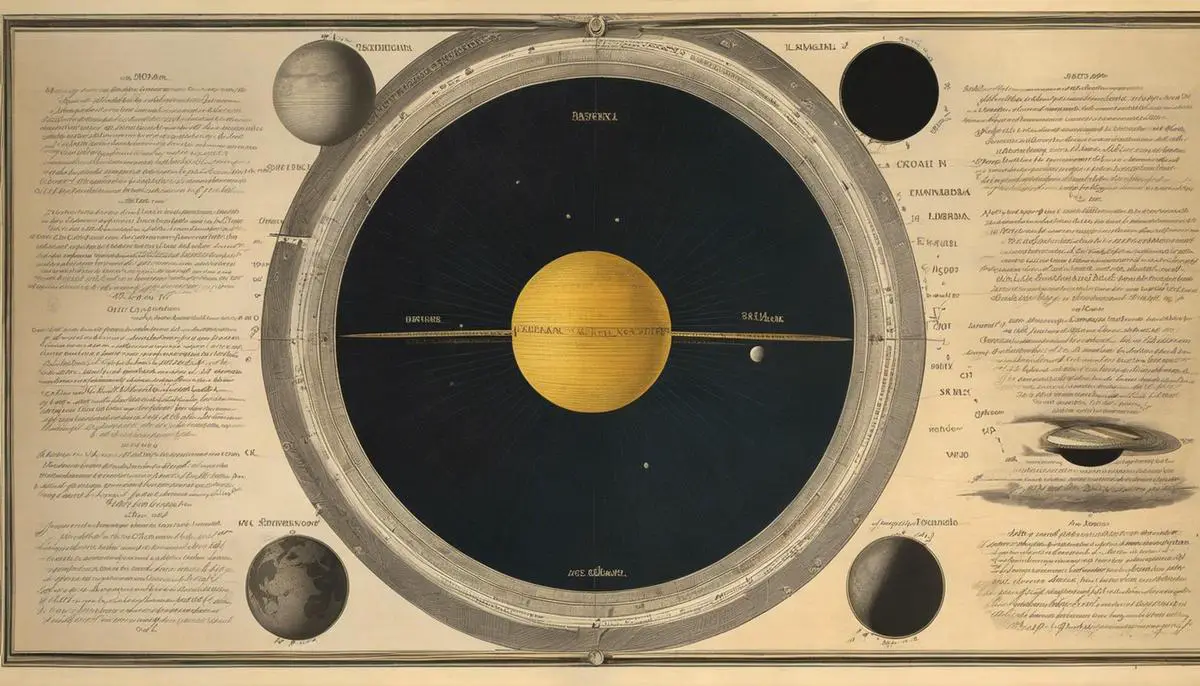When the celestial ballet aligns the Sun, Earth, and Moon into perfect syzygy, a dramatic nocturnal spectacle graces the skies: a lunar eclipse. The marvel of a lunar eclipse has captivated human imagination since ancient times, weaving a tapestry of awe, mythology, and scientific curiosity throughout human history. As the Earth casts its shadow upon our celestial companion, not only does it manifest one of nature’s most captivating phenomena, but it also serves as a testament to the precision of celestial mechanics. The following discourse seeks to illuminate the intricacies of lunar eclipses, unwrapping the layers of their fundamental nature, historical resonance, and the joy they offer to observers and photographers alike.
Fundamentals of Lunar Eclipses
Title: Unraveling the Celestial Dance: The Mechanics of a Lunar Eclipse
As night enfolds the terrestrial sphere, occasionally the celestial ballet yields a remarkable phenomenon: the lunar eclipse. During a lunar eclipse, our planet positions itself directly between the Sun and the Moon, casting a shadow upon the latter. This event is not merely a fortuitous alignment; it is the culmination of precise orbital mechanics that govern the movement of celestial bodies.
The fundamental principle behind a lunar eclipse is straightforward: it occurs during a full moon when the Sun, Earth, and Moon align in a near-perfect line, an arrangement astronomers call ‘syzygy.’ In this cosmic configuration, the Earth interrupts the stream of sunlight to the Moon.
To understand this spectacle, one must grasp two pivotal elements of celestial mechanics: the orbits of the Moon around Earth and Earth around the Sun, and the shadows these create. The Moon’s orbit is elliptical and inclined by about 5 degrees relative to Earth’s orbital plane – known as the ecliptic. Due to this inclination, the Moon usually passes above or below Earth’s shadow.
However, when the orbits align at the nodes—the points where the Moon’s orbit crosses the ecliptic—the stage is set for an eclipse. The Earth casts two types of shadows on the Moon during an eclipse: the umbra and the penumbra. The umbra is the innermost and darkest part of the shadow, where all direct light from the Sun is blocked. The penumbra is the outer part of the shadow where only a portion of sunlight is obstructed.
There are three types of lunar eclipses: total, partial, and penumbral. A total lunar eclipse transpires when the entire Moon passes through Earth’s umbral shadow and can acquire a coppery hue due to Earth’s atmosphere refracting sunlight onto the Moon’s surface, a phenomenon poetically termed the ‘Blood Moon.’ A partial lunar eclipse occurs when only a segment of the Moon travels through the umbra. In contrast, a penumbral lunar eclipse is the most subtle, with the Moon only passing through the penumbra, often imperceptible to the casual observer.
Akin to a delicate minuet, the regularity and occurrence of lunar eclipses are predictable. Mathematicians and astronomers employ meticulous orbital calculations to forecast these events with great accuracy. Eclipses do not occur every month because of the orbital inclinations, but rather in cycles and periods, an example being the Saros cycle, spanning approximately 18 years.
In summary, a lunar eclipse is an intricate dance of light and shadow, orbit and alignment. It serves as an elegant testament to the gravitational symphony that orchestrates our solar system—a demonstration of celestial mechanics in its most visually compelling form. Witnessing a lunar eclipse is a humbling reminder of Earth’s place in the vast expanse of space, anchored in the precise laws of physics that continue to captivate astronomers and enthusiasts alike.
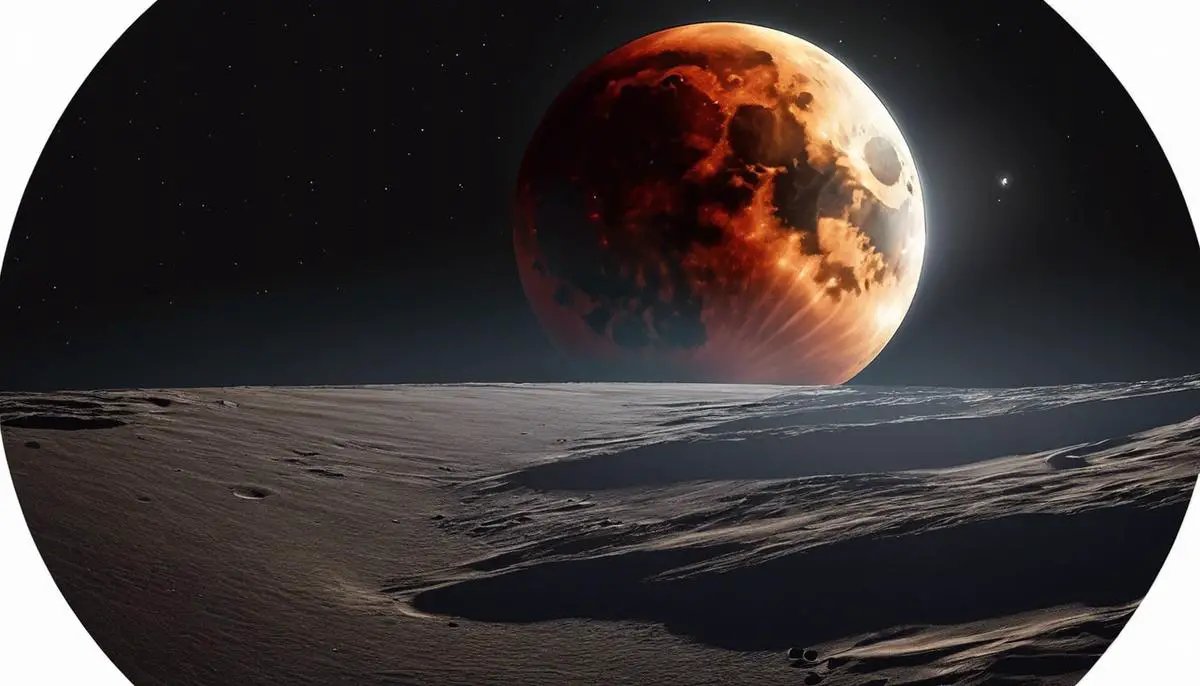
Historical and Cultural Significance
Throughout history, lunar eclipses have significantly influenced human culture, often leaving a profound imprint on the psyche of civilizations. The diverse interpretations and responses to these celestial events, spanning cultures and epochs, reveal much about the human quest for meaning and our relationship with the cosmos.
Ancient societies commonly viewed lunar eclipses through a mythological lens, with explanations rooted in folklore and divine narratives. The Incas, for instance, believed that a jaguar was attacking the moon during an eclipse, which caused the darkened hue. They would attempt to scare away the celestial jaguar by creating noise and commotion. In ancient Mesopotamia, eclipses were ominous signs, believed to foretell disaster or the king’s impending doom. As a countermeasure, Mesopotamians would install a surrogate king to absorb the portended misfortune, thus protecting the true king.
On the other side of the world, the ancient Chinese saw eclipses as an assault by a dragon. The concept was similar in its urgency—the populace would band together, banging pots and creating an uproar to fend off the mythical creature. These practices underscore a universal element of human nature: the drive to comprehend and, if possible, influence or control that which we perceive as threatening or uncanny.
As the wheel of time turned towards the modern era, our interpretations of lunar eclipses underwent a transformation, informed by the gradual unshrouding of their astronomical basis. The Hellenistic world contributed significantly to this shift, with scholars such as Ptolemy explicating on the mechanics behind eclipses. This scientific approach yielded a less fearful and more inquisitive stance towards these celestial phenomena.
By the Renaissance period and into the Age of Enlightenment, the systematic study of eclipses was firmly established. Cultural perceptions evolved accordingly; no longer were eclipses solely omens or supernatural phenomena—they became opportunities for scientific inquiry and discovery. Astute observations during these events facilitated the advancement of our understanding of Earth’s place in the solar system, and by extension, the universe.
In certain cultures, though the awe invoked by lunar eclipses has been moderated by understanding, some traditional beliefs persist alongside the scientific explanations. The eclipses continue to be viewed as moments of cosmic significance, serving as focal points for rituals, reflection, or renewal. These contemporary, syncretic attitudes toward lunar eclipses underscore their enduring grip on the human imagination.
In conclusion, lunar eclipses, these stunning alignments of celestial bodies long observed by humanity, serve as profound reminders of our perpetual fascination with the heavens. The shifting perception of such events, from supernatural to scientific, encapsulates humanity’s journey from myth to reason—a journey marked by an unwavering search for understanding that anchors our place in the greater cosmos.
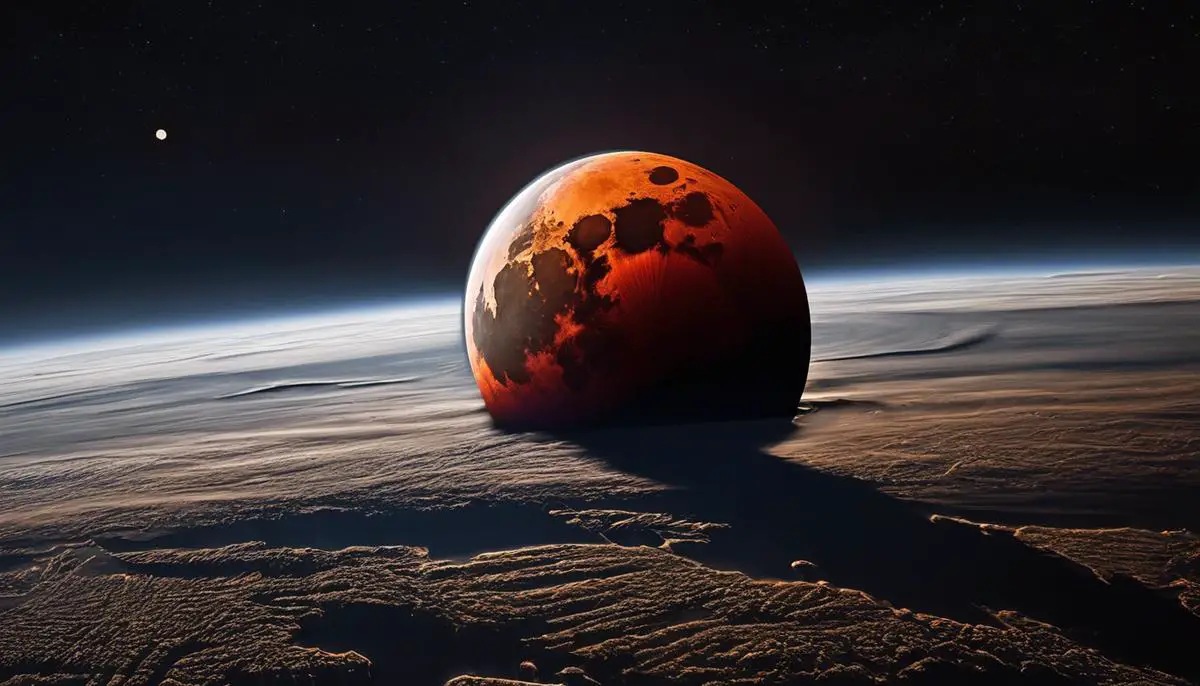
Observation and Photographic Techniques
When endeavoring to observe and photograph a lunar eclipse, it is imperative to adhere to a series of best practices that maximize both the experience and the results of one’s efforts. These practices are informed by the disciplines of astronomy and photography, converging to offer an optimal method for capturing this celestial event.
Firstly, to prepare adequately for a lunar eclipse, one must be aware of the timing and visibility of the event in their geographical region. Utilizing resources such as astronomical almanacs or online tools that provide localized calendars for celestial happenings is essential.
In terms of observation, it is fortuitous to seek a location with a clear, unobstructed view of the sky. Urban environments may introduce light pollution that can diminish the visibility of the eclipse, therefore, a site away from city lights is preferable. As the observing conditions are subject to meteorological variability, it is prudent to monitor weather forecasts and be flexible with location to evade overcast skies.
Photographically, a lunar eclipse presents unique challenges; thus, a certain array of equipment is recommended. A camera with manual settings is indispensable, as it permits a meticulous adjustment of exposure to the fluctuating brightness of the eclipse. Furthermore, a telephoto lens is advantageous for its capacity to closely frame and magnify the moon, while a tripod provides the stability necessary to prevent motion blur during extended exposures.
To capture the nuances of the eclipse, it is beneficial to employ a methodical approach to exposure settings. Starting with a base exposure for the full moon at its normal brightness, incremental adjustments can be made as the moon enters the Earth’s shadow. A range of exposures is advisable to ensure that the final images convey the range of tones from the bright penumbral light to the deep reds and browns of the totality phase.
Equally important is the human aspect of the eclipse observation. One should not be excessively preoccupied with recording the event to the detriment of witnessing it. It is a delicate balance between living the event through the viewfinder and appreciating it with unmediated vision.
Lastly, the final stages of the eclipse may offer the most dramatic and rapidly changing light conditions. Concentrated observation and readiness to adjust camera settings swiftly are essential during the ending phases to secure a comprehensive depiction of the event.
By integrating these best practices, observers and photographers can profoundly appreciate the splendor of a lunar eclipse, bridging the gap between the awe-inspiring celestial display and its eternal imprint through the art of photography.
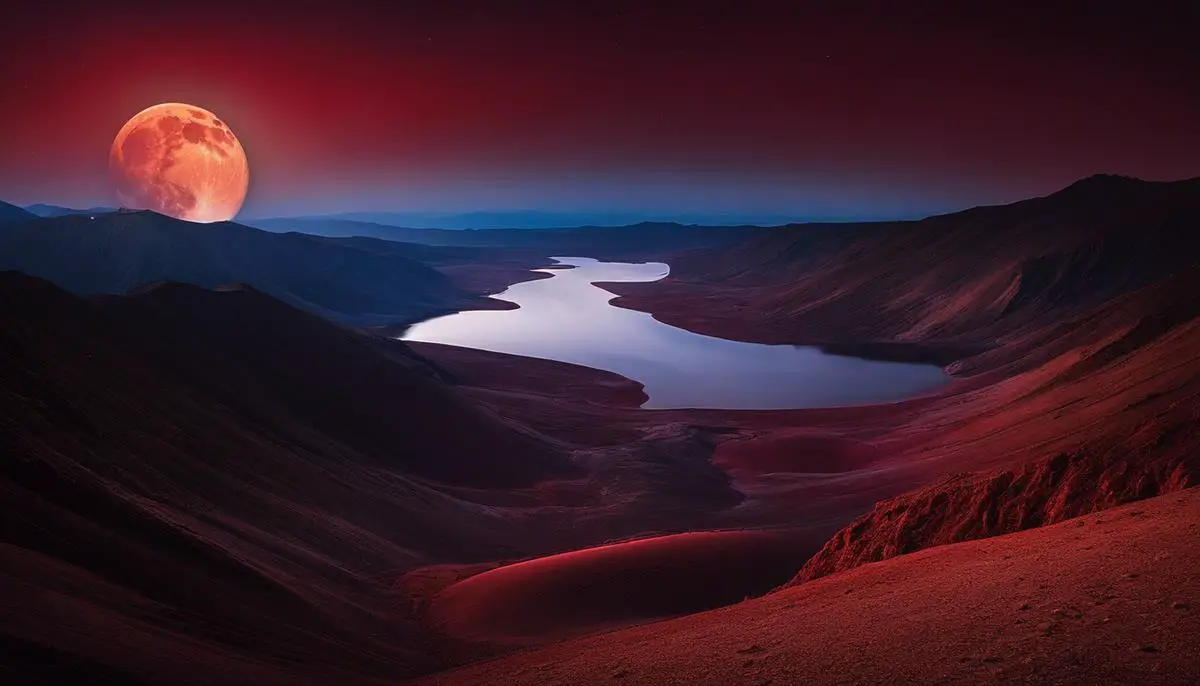
Predictive Models and Future Eclipses
To engage in the scientific venture of predicting lunar eclipses, one employs rigorous data from astronomical observations and implements computational models to forecast these events with exquisite precision. This predictive science is grounded in an understanding of the fundamental periodicity of the Moon’s motion, known succinctly as the Saros cycle—a period approximately 18 years, 11 days, and 8 hours long, when the geometry of the Sun, Earth, and Moon repeats nearly exactly, thereby giving rise to a similar eclipse.
On this basis, eclipse scientists can anticipate not only the occurrence of lunar eclipses but also their timing and visibility for various locations on Earth. With an ensemble of data inputs and orbital mechanics informing model parameters, this rigorous method allows for the production of eclipse calendars years into the future. These schedules delineate the date and time at which the initial penumbral contact occurs up until the concluding moments as the Moon exits the shadows.
When planning observational activities, one seeks out locales with optimal conditions — minimal light pollution, clear skies, and an unobstructed horizon. These variables are crucial for an unimpeded view. For those documenting the event through photography, the advice is to prepare thoroughly. Cameras should be equipped with adequate lenses to capture the grandeur of the Moon, and settings moderated to ensure clarity and detail during the varying degrees of luminosity through the eclipse’s progression.
In the final stages, acuity is advised, both to record the de-escalating shadow and to internalize the splendor of the Moon’s re-emergence. Essentially, while one is steeped in rigorous scientific understanding, the experiential element must not be forfeited.
Incorporating these observational strategies ensures a rewarding encounter with one of nature’s most ethereal spectacles. As for the next anticipation, models predict the forthcoming lunar eclipse shall grace our celestial stage on the forthcoming calendar date, aligning with the algorithmically derived epoch within the Saros cycle, so that enthusiasts may witness this astronomical pageant once more.
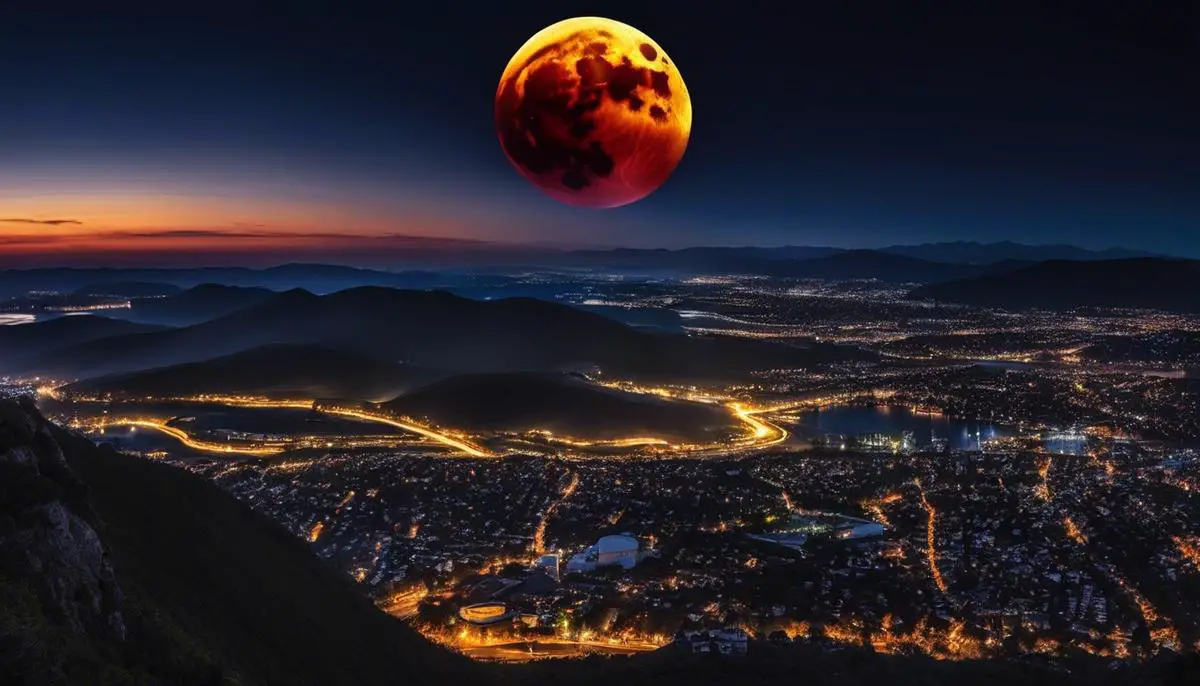
Embarking on a journey through the night sky to decode the enigma of lunar eclipses brings us face to face with the inexorable dance of cosmic bodies. This celestial choreography, far from being a mere spectacle, stitches itself into the fabric of our shared human experience, bridging the gap between science and fascination. As the Earth prepares to cast its shadow once more in January 2024, both avid skywatchers and casual onlookers alike can partake in this grand astronomical tradition. The lunar eclipse not only offers a window into the past, where echoes of ancestral wisdom still resonate, but also a glimpse into the future, bright with the potential for discovery and wonder.
![]()
